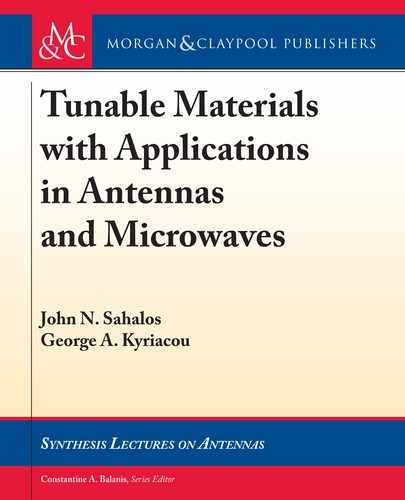
2.23. FERROELECTRIC MICROWAVE LOSSES 63
2.23 FERROELECTRIC MICROWAVE LOSSES
Usually, incipient (e.g., SrTiO
3
or BaTiO
3
) or conventional ferroelectrics of the displacive type
(e.g., BSTO) in their paraelectric phase (above the curie temperature) are used in microwave
tunable applications. Microwave losses in bulk thick or thin films are studied in the work of
Guverich and Tagantsev [65], Tagantsev et al. [39], and Vendik et al. [63]. In the fundamental
loss mechanism, due to interaction of the AC field with the phonons of ferroelectrics in bulk
form, the term “intrinsic losses” was introduced [39, 65]. ese losses are due to the absorp-
tion of energy quantum, (
hf
D „
!
), when collisions of microwave photons with crystal lattice
phonons occur. However, when ferroelectric films are employed, an additional loss mechanism
should be included owing to the coupling of the microwave field with defects. is is referred
in [39, 65] as “extrinsic losses.” A detailed in-depth analysis of the loss mechanism is given in
the review paper of Tagantsev et al. [39].
2.23.1 INTRINSIC LOSSES
Intrinsic losses come from the fundamental loss mechanism established for crystalline materials
with a well-defined phonon spectrum. According to this theory, which is based on a quantum
mechanics approach, the fundamental loss is mainly due to the absorption of quantum energy
(E
q
D hf D „!) in collisions of microwave photons with thermal phonons, which have much
higher energy. e great difference in energy causes difficulties in the satisfaction of conserva-
tion laws, and this complicated situation is described in the following three different absorption
mechanisms [39]: (i) three-quantum, (ii) four-quantum, and (iii) quasi-Debye mechanism. In
the three- and four-quantum mechanisms, the absorption of a field quantum („!) involves two
and three phonons, respectively. Vendik et al. [63] refer to mechanisms (i) and (ii) as a “multi-
phonon scattering of the soft ferroelectric mode.” Unlike in the quasi-Debye mechanism [63],
they deal with the “transformation of microwave oscillations to acoustic ones due to scattering
by regions with residual ferroelectric polarization.” e total loss tangent tan ı is the summation
of tan ı resulting from each mechanism [39, 49].
According to Tagantsev et al. [39], for tunable materials of the soft ferroelectric mode,
both three- and four-quantum mechanisms yield a microwave dielectric loss:
tan ı
ph
D
"
00
ph
"
/ !T
2
"
3=2
: (2.54)
Equation (2.54) is valid under the following conditions:
(a) In the three-quantum mechanism, the frequency should be lower than that of the damping
of the phonons (! r); in other words, the frequencies of interphonon collisions must be
lower than the phonon frequency in the crystal. For incipient ferroelectrics, such as SrTiO
3
or KTaO
3
, the limit ! r means that f 100 GHz [39].

64 2. TUNABLE MATERIALS–CHARACTERISTICS AND CONSTITUTIVE PARAMETERS
(b) In the four-quantum mechanism, the temperature should be high enough so that K
B
T
„
TO
, which is the most common practical case. e symbol K
B
is Boltzman’s constant,
and
TO
is the circular frequency of the lower transverse optical mode (optical phonons).
Even though the three- and four-quantum mechanisms give the same dependence of tan ı
on frequency (notice the linearity in terms of !), temperature, and the dielectric constant, the
three-quantum mechanism is dominant and yields an order of magnitude of higher losses, as
can be seen in Figure 2.31.
Tan δ
ξ
ξ
2
ξ
3
Γ
0
Ω
0
ω
3 1
2
Figure 2.31: Contribution of the different mechanisms to the microwave losses of incipient ferro-
electric: 1. ree-quantum, 2. Four-quantum, and 3. Quasi-Debye mechanisms. ( D
0
=
O
).
It is important to note that, besides the fundamental losses, the nonlinear interaction be-
tween the soft ferroelectric mode and the thermal oscillations of the crystal lattice (multiphonon
interaction) is also responsible for the ferroelectric phase transition, which reveals the high di-
electric constant of the material [63].
e quasi-Debye mechanism contributes to the losses in non-centro-symmetric crys-
tals [39]. In this case, the oscillations of the AC field modulate phonon frequencies, including a
deviation from their equilibrium distribution. A relaxation of the phonon distribution, similar to
the relaxation of dipole distribution, (original Debye theory), gives rise to a corresponding loss.
Recall that ferroelectrics are usually used in microwave applications in their paraelectric phase, in
which they exhibit a highly centro-symmetric crystalline structure. However, this is exactly true
only in the absence of a DC biasing electric field, which is able to break the central symmetry
and, in turn, activate the quasi-Debye loss mechanism, (DC field-induced quasi-Debye mech-
anism). When activated, this mechanism may represent the dominant contribution to losses for
relatively low frequencies, (lower than 100 GHz) and reads as follows [39]:
tan ı
QD
.
E
dc
/
D A ! I
.
E
dc
/
n
r
; (2.55)
where n
r
is the relative tunability given in Eq. (2.48).
..................Content has been hidden....................
You can't read the all page of ebook, please click here login for view all page.
